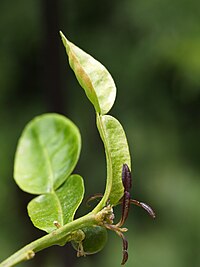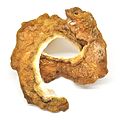泰國青檸
| 泰國青檸 | |
|---|---|

| |
| 科學分類 | |
| 界: | 植物界 Plantae |
| 演化支: | 維管束植物 Tracheophyta |
| 演化支: | 被子植物 Angiosperms |
| 演化支: | 真雙子葉植物 Eudicots |
| 演化支: | 薔薇類植物 Rosids |
| 目: | 無患子目 Sapindales |
| 科: | 芸香科 Rutaceae |
| 屬: | 柑橘屬 Citrus |
| 種: | 泰國青檸 C. hystrix
|
| 二名法 | |
| Citrus hystrix DC. Cat., 1813
| |
| 異名[1] | |
| |
泰國青檸(學名:Citrus hystrix),又名箭葉橙、馬蜂橙、泰國萊姆、卡菲爾青檸、泰國檸檬、痲瘋柑,為芸香科柑橘屬下的一個種,原產於東南亞熱帶地區[2]。其葉片常用於東南亞料理中增添香氣,有時也使用其果皮。一些地區的民俗療法會利用其果皮或果汁。泰國青檸的精油常用於美妝品[3]和保健食品中。
名稱
[編輯]
泰國青檸又被稱為「卡菲爾青檸」(Kaffir Lime),該名的最可能來源是斯里蘭卡卡菲爾,他們部分是被奴役的班圖人的後裔[4]。最早使用「卡菲爾青檸」一名的書籍可追溯至1888年[4][5]。
各地別名
[編輯]- 印尼:jeruk purut;馬來西亞:limau purut (「Purut」意思是表皮粗糙,形容泰國青檸凹凸不平的表皮[6]
- 菲律賓:kabuyaw 或 kulubot [7]。內湖省的卡布堯市(Cabuyao)就是以泰國青檸命名[7]。
- 泰國:makrud 或 makrut (มะกรูด, /máʔ.krùːt/)(該名在泰語亦可指香檸檬)
- 老撾:mak khi hut (ໝາກຂີ້ຫູດ, /ma᷆ːk.kʰi᷆ː.hu᷆ːt/)
- 越南:trúc 或 chanh sác[8]
- 法屬留尼汪島:combava
原產於菲律賓的小花大翼橙是不少混種青檸的祖種,如墨西哥萊檬和波斯青檸。 小花大翼橙和泰國青檸可能屬於同一品種,但後者的基因組數據不足以得出明確的結論[9]。
描述
[編輯]泰國青檸是一種多刺灌木,高 2 至 11 米,具有芳香且形狀獨特的「雙」葉[10][11]。 這些沙漏形的葉子由葉片和扁平的葉狀莖(或葉柄)組成。 果實粗糙,呈綠色,成熟時呈黃色; 它的特點是其凹凸不平的外部和小尺寸,大約 4 厘米(2 英寸)寬[11]。
應用
[編輯]食用
[編輯]
泰國青檸的葉片是泰國[12][13](如冬蔭)和柬埔寨料理[14] 的常見材料。在越南菜中,泰國青檸的葉子亦會被用作為雞肉菜餚增添香味,並減少蒸蝸牛時的刺鼻氣味。 另外,在越南收蠶的村莊里,處於蛹期的蠶會與檸檬葉一起炒[15]。泰國青檸葉子在印度尼西亞菜(尤其是峇里菜和爪哇菜)中用於製作印尼雞湯等食物,並與黃金蒲桃一起用於烹調雞肉和魚。 它們也出現在馬來西亞和緬甸菜中。[16]
泰國青檸的果皮亦常用於製作老撾及泰國咖喱醬,以添加芳香及澀味[12]。在毛里裘斯、留尼汪島及馬達加斯加的克里奧爾菜中,泰國青檸果皮會被用於為蘭姆酒調味[17]。
藥用
[編輯]在一些亞洲國家,泰國青檸果皮的汁液和果皮被用作傳統藥物; 這種果汁經常用於洗髮水中,並被認為可以殺死頭蝨[11]。
其他用途
[編輯]在泰國[13],泰國青檸果汁被用作衣服和頭髮的清潔劑,偶爾在柬埔寨也被使用。 在柬埔寨,浸過聖水的泰國青檸果片會被用於宗教儀式。
泰國青檸果油是許多產業的原料,包括製藥、農藝、食品、衛生、化妝品和香水行業。 它還廣泛用於芳香療法,作為各種化妝品和美容產品的基本成分。[19]
泰國青檸亦會被種在花盆、花園、陽台及溫室裏,以供應果實及葉片。
成分
[編輯]
為泰國青檸產生獨特香氣的化合物已被鑑定為 (–)-(S)-香茅醛,在葉油中的含量高達 80%; 次要成分包括香茅醇(10%)、橙花醇和檸檬烯。
從立體化學的角度來看,泰國青檸葉的特別之處是,它僅含有香茅醛的 (S) 立體異構體,而其對映體 (+)-(R)-香茅醛則存在於檸檬香脂和香茅(香茅醛只是香茅精油中的微量成分)。
泰國青檸果皮含有與青檸果皮油相當的精油; 主要成分為檸檬烯和 β-蒎烯。[3][20]
毒性
[編輯]泰國青檸果皮和果肉中都含有大量的呋喃香豆素[21]。呋喃香豆素已知會引起植物日光性皮炎[22],一種潛在的嚴重皮膚炎症。 已有因外用泰國青檸誘發植物日光性皮炎的病例報導[23]。
參考資料
[編輯]- ^ The Plant List: A Working List of All Plant Species, [3 October 2015], (原始內容存檔於2020-09-19) (頁面存檔備份,存於互聯網檔案館)
- ^ Citrus hystrix. Plant Finder. Missouri Botanical Garden. [13 August 2018]. (原始內容存檔於2019-12-18). (頁面存檔備份,存於互聯網檔案館)
- ^ 3.0 3.1 Ng, D.S.H.; Rose, L.C.; Suhaimi, H.; Mohamad, H.; Rozaini, M.Z.H.; Taib, M. Preliminary evaluation on the antibacterial activities of Citrus hystrix oil emulsions stabilized by TWEEN 80 and SPAN 80 (PDF). International Journal of Pharmacy and Pharmaceutical Sciences. 2011, 3 (Suppl. 2) [2023-07-10]. (原始內容 (PDF)存檔於2018-04-12). (頁面存檔備份,存於互聯網檔案館)
- ^ 4.0 4.1 Anderson, L. V. Is the Name Kaffir Lime Racist? Why You May Want to Think Twice About Using That Term.. Slate Magazine. 3 July 2014 [1 May 2021]. (原始內容存檔於2023-07-10) (英語). (頁面存檔備份,存於互聯網檔案館)
- ^ pann. Apa itu purut?. Glosarium Online. 2019-04-07 [2020-09-02]. (原始內容存檔於2021-07-04) (印度尼西亞語). (頁面存檔備份,存於互聯網檔案館)
- ^ 7.0 7.1 CRC World Dictionary of Medicinal and Poisonous Plants: Common Names, Scientific Names, Eponyms, Synonyms, and Etymology. M-Q. CRC Press/Taylor & Francis. 2012-01-01. ISBN 9781439895702 (英語).
- ^ Katzer, Gernot. Kaffir Lime (Citrus hystrix DC.). Gernot Katzer's Spice Pages. [13 August 2018]. (原始內容存檔於2018-10-18). (頁面存檔備份,存於互聯網檔案館)
- ^ Ollitrault, Patrick; Curk, Franck; Krueger, Robert. Citrus taxonomy. Talon, Manuel; Caruso, Marco; Gmitter, Fred G Jr. (編). The Citrus Genus. Elsevier. 2020: 57–81. ISBN 9780128121634. S2CID 242819146. doi:10.1016/B978-0-12-812163-4.00004-8.
- ^ Kumar, Kuntal. The Original Organics Cookbook: recipes for healthy living. TERI Press. 1 January 2008: 54. ISBN 978-81-7993-155-4.
- ^ 11.0 11.1 11.2 Staples, George; Kristiansen, Michael S. Ethnic Culinary Herbs: A Guide to Identification and Cultivation in Hawai'i. University of Hawaii Press. 1 January 1999: 27–29. ISBN 978-0-8248-2094-7.
- ^ 12.0 12.1 Loha-unchit, Kasma. Kaffir Lime –Magrood. [December 7, 2014]. (原始內容存檔於2019-05-09). (頁面存檔備份,存於互聯網檔案館)
- ^ 13.0 13.1 Sukphisit, Suthon. Clean up in kitchen with versatile fruit. Bangkok Post. 12 November 2017 [13 November 2017].
- ^ What to Replace Kaffir Lime Leaves With. Village Bakery. 2018-12-17 [2018-12-19]. (原始內容存檔於2019-11-28) (美國英語). (頁面存檔備份,存於互聯網檔案館)
- ^ How Mountains Of Worm Cocoons Are Turned Into Expensive Silk In Vietnam | Big Business. [2023-07-10]. (原始內容存檔於2023-09-07). (頁面存檔備份,存於互聯網檔案館)
- ^ Wendy Hutton, Wendy; Cassio, Alberto. Handy Pocket Guide to Asian Herbs & Spices. Singapore: Periplus Editions. 2003: 40. ISBN 978-0-7946-0190-4.
- ^ Mauritian rum has a distinct character to it: Sweeter and smoother. The Economic Times. 2015-03-22 [2023-07-10]. (原始內容存檔於2018-11-24). (頁面存檔備份,存於互聯網檔案館)
- ^ Dy Phon Pauline, 2000, Plants Used In Cambodia, printed by Imprimerie Olympic, Phnom Penh
- ^ Suresh, Anuja; Velusamy, Sangeetha; Ayyasamy, Sudha; Rathinasamy, Menaha. Techniques for essential oil extraction from makrut lime and its application in health care products—A review. Flavour and Fragrance Journal. 2021, 36: 5–21 [2023-07-10]. S2CID 226314486. doi:10.1002/ffj.3626. (原始內容存檔於2023-04-05). (頁面存檔備份,存於互聯網檔案館)
- ^ Kasuan, Nurhani. Extraction of Citrus hystrix D.C. (Kaffir Lime) Essential Oil Using Automated Steam Distillation Process: Analysis of Volatile Compounds (PDF). Malaysian Journal of Analytical Sciences. 2013, 17 (3): 359–369 [2023-07-10]. (原始內容存檔 (PDF)於2020-08-06). (頁面存檔備份,存於互聯網檔案館)
- ^ Dugrand-Judek, Audray; Olry, Alexandre; Hehn, Alain; Costantino, Gilles; Ollitrault, Patrick; Froelicher, Yann; Bourgaud, Frédéric. The Distribution of Coumarins and Furanocoumarins in Citrus Species Closely Matches Citrus Phylogeny and Reflects the Organization of Biosynthetic Pathways. PLOS ONE. November 2015, 10 (11): e0142757. Bibcode:2015PLoSO..1042757D. PMC 4641707
 . PMID 26558757. doi:10.1371/journal.pone.0142757
. PMID 26558757. doi:10.1371/journal.pone.0142757  .
.
- ^ McGovern, Thomas W.; Barkley, Theodore M. Botanical Dermatology. The Electronic Textbook of Dermatology (Internet Dermatology Society). 2000, 37 (5). Section Phytophotodermatitis [November 29, 2018]. PMID 9620476. S2CID 221810453. doi:10.1046/j.1365-4362.1998.00385.x. (原始內容存檔於2017-06-01). (頁面存檔備份,存於互聯網檔案館)
- ^ Koh, D.; Ong, C. N. Phytophotodermatitis due to the application of Citrus hystrix as a folk remedy. Br J Dermatol. April 1999, 140 (4): 737–738. PMID 10233333. S2CID 45603195. doi:10.1046/j.1365-2133.1999.02782.x.
- 箭叶橙 Citrus hystrix. 中國植物物種信息數據庫. [2013-01-15]. (原始內容存檔於2021-08-23). (頁面存檔備份,存於互聯網檔案館)







